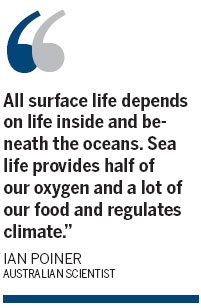Life and Leisure
Census brings to life 'extinct' marine species
By Pat Reber (China Daily)
Updated: 2010-10-14 07:57
 |
Large Medium Small |
Scientists thought it had been extinct for 50 million years.
But as thousands of marine experts combed the world's oceans taking a decade-long Census of Marine Life, they found a pink Jurassic shrimp in the waters off Australia.
In the Caribbean, they discovered a living fossil - a type of deep-water clam that flourished for 100 million years, then seemed to have disappeared in the 1800s.
In early October in London, marine scientists were delivering the final Census of Marine Life, a gigantic international effort that discovered new species - like the hairy "yeti" crab living on a toxic vent near Easter Island - mapped the ocean floors and established a baseline to monitor the health of ocean life.
The results have revealed how little is known about what swims, gurgles, drifts and attacks in the brine that covers three-quarters of the globe. While only 230,000 forms of marine life had been identified before the project started, the "known" quantity has been upped to 250,000 through more careful methods of identification, the scientists say.
In addition, 6,000 possible new species were identified. And there are likely more than 750,000 species yet to be discovered of the 1 million or so thought to exist.

"All surface life depends on life inside and beneath the oceans," says Ian Poiner, an Australian scientist and chair of the census steering committee. "Sea life provides half of our oxygen and a lot of our food and regulates climate. We are citizens of the sea."
One is easily overwhelmed by the numbers: 2,700 scientists from 80 countries braved rough seas, chilling waters and elusive creatures to compile the census. They used airplanes and sonar, planted microphones and tracking devices, and made 6.4 million data records.
The material they gathered will take years to analyze for things like DNA coding and travel patterns.
Then there are the microbes, which are not included in the estimated 1 million marine species: By weight, about 90 percent of marine life is microbial - equal to the weight of about 35 elephants for every living person, the scientists say in their Highlight of a Decade of Discovery.
Apart from the microbes, the scale ranged in size from pinhead to giant: The tiny Nanaloricus cinzia was identified this year as the first animal known to live without oxygen, nestled in the sediment in the deep Mediterranean sea; while the strange-looking 7-meter-long bigfin squids were discovered in waters deeper than 1,000 meters, propelling themselves with large fins and bending their tentacles with elbow-like joints.
"The Census found living creatures everywhere it looked, even where heat would melt lead, seawater froze to ice, and light and oxygen were lacking," the highlights report says. "It expanded known habitats and ranges in which life is known to exist. It found that in marine habitats, extreme is normal."
The $650 million census effort was launched at the 1992 Earth Summit on Biodiversity in Rio de Janeiro and was funded by a broad coalition of organizations.
DPA